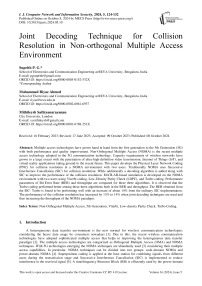Joint Decoding Technique for Collision Resolution in Non-orthogonal Multiple Access Environment
Автор: Suprith P.G., Mohammed Riyaz Ahmed, Mithileysh Sathiyanarayanan
Журнал: International Journal of Computer Network and Information Security @ijcnis
Статья в выпуске: 5 vol.16, 2024 года.
Бесплатный доступ
Multiple access technologies have grown hand in hand from the first generation to the 5th Generation (5G) with both performance and quality improvement. Non-Orthogonal Multiple Access (NOMA) is the recent multiple access technology adopted in the 5G communication technology. Capacity requirements of wireless networks have grown to a large extent with the penetration of ultra-high-definition video transmission, Internet of Things (IoT), and virtual reality applications taking ground in the recent future. This paper develops the Physical Layer Network Coding (PNC) for collision resolution in a NOMA environment with two users. Traditionally NOMA uses Successive Interference Cancellation (SIC) for collision resolution. While additionally a decoding algorithm is added along with SIC to improve the performance of the collision resolution. MATLAB-based simulation is developed on the NOMA environment with two users using Viterbi coding, Low-Density Parity Check (LDPC), and Turbo coding. Performance parameters of Bit Error Rate (BER) and throughput are compared for these three algorithms. It is observed that the Turbo coding performed better among these three algorithms both in the BER and throughput. The BER obtained from the SIC- Turbo is found to be performing well with an increase of about 14% from the ordinary SIC implementation. The performance of the collision resolution has increased by 13% to 14% when joint decoding techniques are used and thus increasing the throughput of the NOMA paradigm.
Non-Orthogonal Multiple Access, 5th Generation, Viterbi, Low-density Parity Check, Turbo Coding
Короткий адрес: https://sciup.org/15019478
IDR: 15019478 | DOI: 10.5815/ijcnis.2024.05.10
Текст научной статьи Joint Decoding Technique for Collision Resolution in Non-orthogonal Multiple Access Environment
A heterogeneous data transfer environment is the new normal for wireless communication technologies considering the heavy data usage by consumers nowadays [1]. Due to this, the recent wireless communication technologies have adopted sophisticated multiple access that helps in improving the heterogeneous data transfer paradigm [2]. The multiple access technologies are categorized as Orthogonal Multiple Access (OMA) and NOMA techniques. With 5G technologies emerging the NOMA techniques are abundantly used [3] considering their multiple access capabilities. In particular, NOMA techniques can be divided into two groups: code-domain NOMA and power-domain NOMA [4]. Superposition coding is applied at the base station for combining signals from different users during the transmission stage and Successive Interference Cancellation (SIC) is implemented to reduce interference in the received signal [5]. A time/frequency Resource Block (RB) is efficiently used by the power-domain
NOMA for multiple users with SC techniques at the transmission side and SIC at the receiver side [6]. A two-user game is analyzed on the NOMA random access platform to check the performance of transmission probability and pay off region [7]. The throughput and the access fairness of the NOMA random access system is controlled by optimally choosing the transmission probability and target receive power [8, 9]. NOMA being advantageous than the previous multiple access systems from the first generation to the fourth generation is the choice for the 5th generation wireless communication system. A major drawback of the NOMA system is the collision occurring while multiple users communicate with the single base station. Thus, collision resolution or collision reduction algorithms take the center stage while NOMA implementation is developed. A collision resolution period (CRP) is introduced in the NOMA implementation where the collided packets are transmitted to improve the throughput and transmission probability [10]. Multiple signals when approaching the base station uses the RB which has stipulations. Thus, round trip delay (RTD) of the signals is estimated which helps to improve the throughput by implementing SIC in the time domain [11]. Even numbers of signals are estimated using RTD. SIC based NOMA and proportional fair scheduling based multiuser diversity (MUD) is combined by switching between these two algorithms to obtain a high sum-rate gain in a multi-access environment [12]. Estimation of number of users and simultaneously controlling the transmission capability of the user is possible using the online method applying Bayesian approach [13].
The literature review is presented in Section 2 on scrambling, coding, interleaving, and spreading-based NOMA schemes. Section 3 explains the paper's contribution. Section 4 presents Joint Decoding on NOMA Strategy. Section 5 explains the experimental results and discussion for forward error correction codes Viterbi, LDPC and Turbo for both far and near users. The conclusion of the proposed research work is contained in Section 6.
2. Related Works
NOMA based techniques have outperformed traditional techniques both in improving the throughput and collision probability [14]. A vehicle-to-anything application uses time frequency resource to avoid collision in the NOMA environment. It uses the uncoordinated transmission of data by means of specially designed transmit signatures and the receiver that utilizes this signature structure [15]. Different NOMA schemes including the scrambling-based NOMA, coding-based NOMA, interleaving NOMA, spreading based NOMA and coding based NOMA are discussed in the literature [16, 17]. Physical layer NOMA uses LDPC algorithm for on the bit interleaved coded multiple access implementation. Multiuser interference is largely reduced since LDPC encoder is adopted in the implementation [18]. Performance of the NOMA implementation improved while LDPC encoder and decoder are used for transmission and receiver side respectively [19]. The computational complexity of the NOMA implementation is kept in an acceptable level while both conventional and cooperative LDPC is implemented in the NOMA paradigm [20]. Higher throughput is achieved in the multiple-access wireless communication paradigm enabling both the collision resolution and decoding [21]. Random Access LDPC (RA LDPC) is introduced in the multiple access paradigms. Nested LDPC is added in the random-access coding strategy in the implementation and error exponent analysis is found to be satisfactory [22]. The throughput of the NOMA network can be concluded when taking the comparative analysis between Viterbi, LDPC, and Turbo codes. There is a percentage improvement in BER from SIC to SIC-Viterbi, SIC-LDPC, and SIC-Turbo codes. The obtained experimental results provide using SIC-Turbo codes an increase in BER values when compared to other codes.
3. Paper Contribution
Various block coding algorithms are used in random access paradigm [23, 24] to improve the performance of data delivery in wireless communication systems by improving the throughput and reducing the interference in the data. NOMA implementation in 5G environment are applied for better performance by optimizing the power allocation using meta-heuristic method [25, 26] and automated user installation [27]. This paper exploits the capability of NOMA paradigm in utilizing the available resource efficiently with higher quality of service maintained in the wireless communication paradigm. This paper applies the joint decoding along with the SIC algorithm in the NOMA environment. A performance comparison of Viterbi, LDPC and Turbo code on the NOMA implementation is developed and the Bit Error Rate and throughput for each algorithm on NOMA environment is developed.
4. Joint Decoding on NOMA Strategy
NOMA implementation with collision resolution using SIC is extended in this implementation combining the forward error correction codes with the SIC implementation in the receiver end. NOMA is implemented in power domain-based implementation where the users using the same time and frequency resources are multiplexed. The type 2 collision resolutions are considered in this implementation with SIC as the first level and decoding using forward error corrections codes for collision reduction. In data transmission systems, forward error correction (FEC) continues to play an extremely important role. A limited number of errors in transmitted data can be found and fixed using the forward error correction (FEC) technique without the need for retransmission. In this approach, the sender additionally includes an error-correcting code in the data frame. The additional redundant bits are used by the receiver to perform the necessary checks. If it determines that the data is error-free, it runs the code that creates the actual frame to correct any errors. Before sending the message to the upper layers, it then eliminates the unnecessary bits. FEC allows for the simultaneous broadcasting of data to numerous destinations from a single source without the need for handshaking between the source and the destination. FEC also reduces the amount of bandwidth needed for retransmission. As a result, real-time systems use it. When two users use the same frequency simultaneously in the multiple access networks the SC is used to multiplex the data (x1 and x2 for each user) from these two users. Different power levels of the users are defined and assigned to the user data and then these two data are added which is defined as SC. Power level (a1 (far user) and a2 (near user) for each user) defines the priority given to each of the user data. The resultant signal (x) from the SC is the generated using equation (1).
x = 40 1 x 1 + 40 2 x 2 (1)
Thus, higher spectral efficiency is achieved by using the SC in the NOMA signal thus generated as given in equation (1). With the transmit power applied on the superimposed signal the equation (1) is derived as equation (2).
x = 4P(40 1 x 1 + 40 2 x 2 )
Where P is the transmit power for the NOMA signal thus superimposed. The SC signal is the linear combination of both the user data. To the SC response from the equation (1) BPSK modulation is applied on the signal which is superimposed combination of both the user data. The modulated signal is considered to be passing through the Rayleigh fading channel. The Rayleigh fading is modeled as given in the equation (2). The Rayleigh channels for two user data are defined as the term h1 and h2. Although the SC signal passes through both the channels as given in equations (3) and (4). After propagating through the Rayleigh channel, the received signal for near user is,
У 1 = h 1 x + w 1
And for far user is,
У 2 = h 2 x + W 2 (4)
Expanded the equation (3) meant for the near user by substituting (2) in (3) equation (5) is obtained.
У 1 = h 1 4P(40 1 x 1 + 40 2 x 2 ) + w 1
Further expanding the equation (5) equation (6) is obtained with three separate terms: dominating signal, low power signal and the noise. The first term is the dominating term followed by low power and noise terms in equation (6).
У 1 = h14P40 1 x1 + h 1 4P40 2 x2 + w 1
Since the power allocation for the far signal is higher than the near signal the equation (6) directly decoding the equation (6) gives the far signal values. While for the near signal SIC is applied using the equation (7).
У ‘ =У 2 - 40 1 x 1
Where x 1 which is estimate of signal x 1 is found from the equation given in equation (8).
У 2 = h 2 4P40 1 x 1 + h ^ ^PjCx + W 2
The estimate of the signal x2 is found by decoding the equation (7). SIC implementation is accompanied with the forward error correction codes Viterbi, LDPC and Turbo. Both near and far signals is encoded using these codes before SC is applied on the signals to evaluate the collision resolution in the NOMA paradigm using these encode decoder pairs. The block diagram of the proposed implementation is shown in fig. 1.
Joint decoding implementation uses both the SIC and forward error correction (FEC) algorithms for collision resolution in the NOMA environment with Rayleigh fading channel. The FECs encode the user data individually before the SC is applied to the data and, decades after the estimation from the SIC. Thus, this sequential encoding is defined as joint encoding. MATLAB-based implementation is developed in the NOMA environment for the proposed method and results are discussed in the following section. Viterbi encoding is the convolution-encoded method while LDPC and Turbo methods are blocked encoding methods.
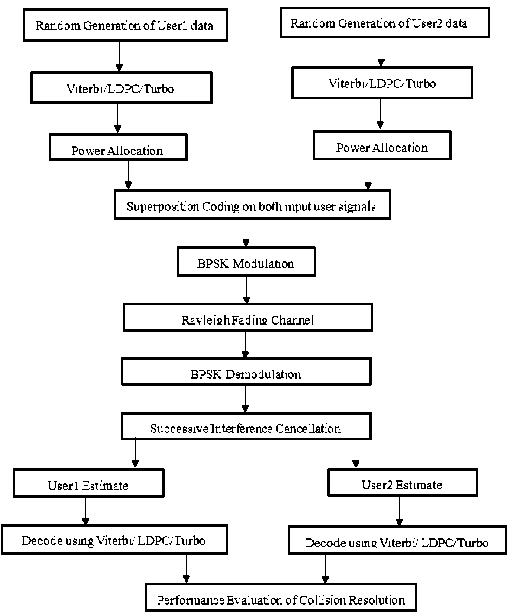
Fig.1. Joint decoding based collision resolution
Viterbi generates the convolution codes using the generator polynomials. The Viterbi algorithm generates the trellis diagram for the input data with the defined code rate in table 2 with the polynomial form as given. Encoded data after the decoding from the SIC algorithm is decoded using the Viterbi algorithm back tracing the Trellis structure. Similarly; LDPC encoding is developed by a generator matrix that is the combination of both the parity matrix and the data to be encoded. Parity matrix H is developed by permutation combination knowing the code rate. Tanner graph that maps the input data on the output data allocates the mapping code for the data transition. After the SIC decoding the iterative LDPC decoder is used that uses Log Likelihood ratio to get the decoded data. Turbo decoder is developed using the unique trellis structure. Two or more components’ encoders concatenated in parallel and then separated by interleaver. Soft decision algorithm is used to decode the data from the SIC output in the Turbo Decoder paradigm.
5. Results and Discussion
The simulation specification of the MATLAB implementation of the method is given in the table 1. NOMA for two users and type 2 collisions is developed and results are observed for all the three different joint decoding implementations.
Table 1. NOMA implementation specifications
|
Parameter |
Units |
User1 |
User2 |
|
Distance from base station |
meters |
1000 |
500 |
|
Range of Transmit Power |
bBm |
0 to 40 |
0 to 40 |
|
System Bandwidth |
MHz |
1 |
1 |
Collision resolution implemented on the NOMA implementation with two users gives the BER graph as given in fig. 2. The obtained simulation results give the BER for all the decoding techniques. To achieve Quality of Service (QoS) the BER value should decrease. From fig. 2 the dark line represents the SIC values and dotted points indicate the theoretical values. The BER values and theoretical values are at the same track line. Hence the BER is found to be tracing the theoretical values. The parameters are fixed for all four algorithms' decoding techniques and a comparative analysis is given in table 2.
Table 2. Joint decoding specifications
|
SIC Parameters |
SIC-Viterbi Parameters |
SIC-LDPC Parameters |
SIC – Turbo Parameters |
|
Number of Data bits 64800 |
Number of Data bits 64800 |
Number of Data bits 64800 |
Number of Data bits 64800 |
|
Distances of users from base station (BS) d1=1000, d2=500 |
Distances of users from base station (BS) d1=1000, d2=500 |
Distances of users from base station (BS) d1=1000, d2=500 |
Distances of users from base station (BS) d1=1000, d2=500 |
|
Power allocation factors a1 = 0.75; a2 = 0.25 |
Power allocation factors a1 = 0.75; a2 = 0.25 |
Power allocation factors a1 = 0.75; a2 = 0.25 |
Power allocation factors a1 = 0.75; a2 = 0.25 |
|
Path loss exponent= 4 |
Path loss exponent= 4 |
Path loss exponent= 4 |
Path loss exponent= 4 |
|
Constraint Length=3, Code Generator Polynomial [2 3 5] Hard decoding |
Code Rate =1/3; Decision Method: 'Soft decision' Maximum Iteration Count: 50 |
Trellis Structure (4, [13 15 17], 13) |
With the above parameters all four implementations compare with the theoretical values.
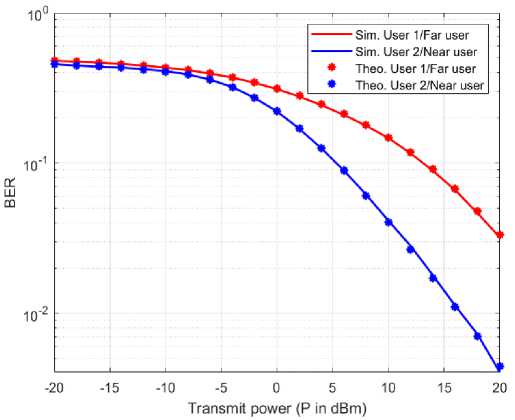
-
Fig.2. BER graph for NOMA with SIC
NOMA collision resolution using the Viterbi algorithm is applied with the 1/3 code rate. The output from the SIC is given as the input to the Viterbi decoder to obtain the BER graph as given in the fig. 3. The obtained simulation result is less than the theoretical values. Thus, the BER obtained is less when compare to NOMA with SIC.
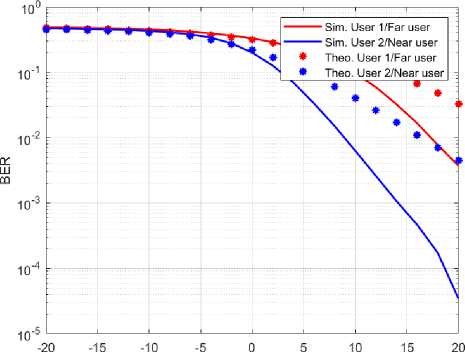
Transmit power (P in dBm)
-
Fig.3. BER graph for NOMA with SIC-Viterbi
It can be observed that the BER from the collision resolution implemented using the SIC-Viterbi algorithm provides the BER competitive than the SIC implementation.
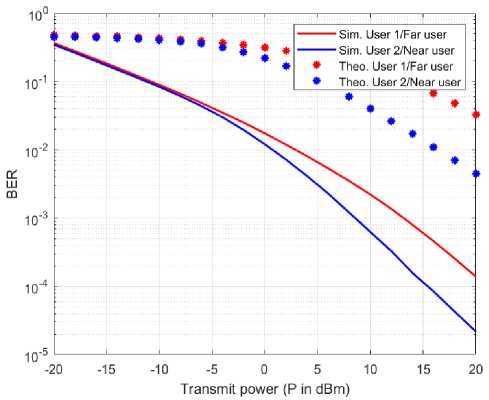
-
Fig.4. BER graph for NOMA with SIC-LDPC
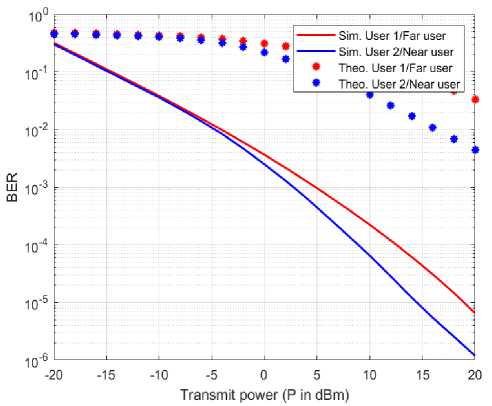
-
Fig.5. BER graph for NOMA with SIC-Turbo
It can be observed from the fig. 4 and fig. 5 implementation that the Turbo and LDPC based implementation has obtained the better than the SIC and SIC-Viterbi implementation. The BER comparison for both the user1 and 2 are for all the considered method is as given in the following graphs as shown in fig. 6 and fig. 7.
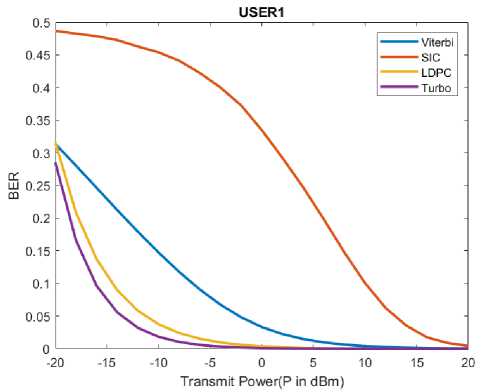
-
Fig.6. User1 BER comparison
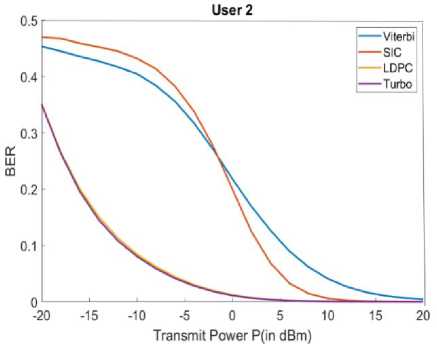
Fig.7. User2 BER comparison
The table of the BER from all the methods discussed is given in table 3 and table 4.
Table 3. SIC and SIC-Viterbi BER
|
Transmit Power (in dBm) |
SIC |
SIC-Viterbi |
||
|
User1 |
User2 |
User1 |
User2 |
|
|
-20 |
0.475586419753086 |
0.453395061728395 |
0.486265432098765 |
0.469598765432099 |
|
-10 |
0.430864197530864 |
0.404614197530864 |
0.451728395061728 |
0.431990740740741 |
|
0 |
0.309043209876543 |
0.218240740740741 |
0.330277777777778 |
0.199891975308642 |
|
10 |
0.146790123456790 |
0.0410648148148148 |
0.0936574074074074 |
0.00606481481481481 |
|
20 |
0.0329938271604938 |
0.00450617283950617 |
0.00402777777777778 |
3.08641975308642e-05 |
Table 4. SIC-LDPC and SIC-Turbo BER
|
Transmit Power (in dBm) |
SIC-LDPC |
SIC-Turbo |
||
|
User1 |
User2 |
User1 |
User2 |
|
|
-20 |
0.368874643874644 |
0.351709401709402 |
0.370617755159740 |
0.347681651116766 |
|
-10 |
0.0895557538155163 |
0.0842516591534214 |
0.0868322387156942 |
0.0802733313498922 |
|
0 |
0.0174680545668332 |
0.0123506017278955 |
0.0161296005135662 |
0.0115706673491253 |
|
10 |
0.00221317767675344 |
0.000596952671063959 |
0.00200211759188682 |
0.000563768740906340 |
|
20 |
0.000128921184968574 |
2.07997842027786e-05 |
0.000120447001194391 |
2.01010889410507e-05 |
It can be observed that the percentage improvement in the BER from SIC-to-SIC Viterbi is 87.79% for user1. It can be observed that the percentage improvement in the BER from SIC-to-SIC Viterbi is 86.34 % for user2. While the percentage increases in the BER value from SIC to SIC-LDPC is 99.61% for user1 and 99.54% for user2. The performance of the collision resolution has increased by 13% to 14% when joint decoding techniques are used and thus increasing the throughput of the NOMA paradigm. Percentage increase in BER values from SIC to SIC-turbo is 99.63% for user1 and 99.55% for user2.
6. Conclusions
Separate decoding and sequential interference cancellation (SIC), two well-known techniques, have served as the foundation for our new decoding scheme, which aims to decode the most innovative packets possible. The optimal solution, which is also the most complex and calls for decoder adjustments, was also studied. It involves jointly decoding all colliding packets and then detecting packet pairings. According to simulation data, the proposed system outperforms separate decoding and SIC by a wide margin. Among the algorithms thus used Turbo Encoder is found to be performing better in terms of the BER obtained. When compared to other decoding techniques, using SIC-Turbo resulted in a lower bit error rate (BER). As a result, the NOMA system throughput and QoS can be achieved using SIC-Turbo decoding. The BER obtained from the SIC-Turbo is found to be performing well with an increase of about 14% from the ordinary SIC implementation. The performance of the collision resolution has increased by 13% to 14% when joint decoding techniques are used and thus increasing the throughput of the NOMA paradigm. Further, the novel optimization algorithm can be used over time for increasing the NOMA network's throughput.
Acknowledgements
We would like to give thanks to the School of Electronics and Communication, REVA University, Bangalore granting access to the experiments and LAB Data sets.
Список литературы Joint Decoding Technique for Collision Resolution in Non-orthogonal Multiple Access Environment
- Qin, Z., Li, F. Y., Li, G. Y., McCann, J. A., & Ni, Q. (2019). Low-power wide-area networks for sustainable IoT. IEEE Wireless Communications, 26, 1–6., doi: 10.1109/MWC.2018.1800264.
- Cai, Y., Qin, Z., Cui, F., Li, G. Y., & McCann, J. A. (2018). Modulation and multiple access for 5G networks. IEEE Communications Surveys & Tutorials, 20, 629–646, DOI: 10.1109/COMST.2017.2766698.
- S. Mohandass and P. Reba, "BER Analysis of Intelligent Reflecting Surface and Relay Assisted NOMA," 2022 International Conference on Intelligent Innovations in Engineering and Technology (ICIIET), Coimbatore, India, 2022, pp. 164-170, doi: 10.1109/ICIIET55458.2022.9967548.
- Yuan, L., Pan, J., Yang, N., Ding, Z., & Yuan, J. (2018). Successive interference cancellation for LDPC coded nonorthogonal multiple access systems. IEEE Transactions on Vehicular Technology, 67, 5460–5464, DOI: 10.1109/TVT.2018.2831213.
- Huang, X., & Yang, N. (2019). On the block error performance of short-packet non-orthogonal multiple access systems. In IEEE Proceedings of International Communication Conference (ICC) (pp. 1–7), DOI: 10.1109/ICC.2019.8761326.
- Yu, H., Fei, Z., Yang, N., & Ye, N. (2018). Optimal design of resource element mapping for sparse spreading non-orthogonal multiple access. IEEE Wireless Communications Letters, 7, 744–747, DOI: 10.1109/LWC.2018.2818157.
- J.-B. Seo and H. Jin, “Two-user NOMA uplink random access,” IEEE Commun. Lett., vol. 22, no. 11, 2246-2249, Nov. 2018, DOI: 10.1109/LCOMM.2018.2867188.
- M. Qu, J. Liu, J.-B Seo and H. Jin,”Distributed fair channel access in NOMA random access systems,” IEEE GLOBECOM, Dec. 9-13, 2019, DOI: 10.1109/GLOBECOM38437.2019.9013283.
- Z. Y. Gao, W. T. Toor, and H. Jin, “CDF-Based Scheduling for Uplink Non-Orthogonal Multiple Access,” IEEE VTC-Spring, pp. 1-5, Jun. 3-6, 2018, DOI: 10.1109/VTCSpring.2018.8417678.
- G. Zhanyang and H. Jin, "Collision Resolution Algorithm for Multi-user NOMA Random Access Systems," 2020 International Conference on Information and Communication Technology Convergence (ICTC), Jeju, Korea (South), 2020, pp. 1121-1123, doi: 10.1109/ICTC49870.2020.9289202.
- L. Bai, R. Han, J. Liu, J. Choi and W. Zhang, "Multiple Delay Estimation for Collision Resolution in Non-Orthogonal Random Access," in IEEE Transactions on Vehicular Technology, vol. 69, no. 1, pp. 497-508, Jan. 2020, doi: 10.1109/TVT.2019.2950474.
- L. Bai, L. Zhu, T. Li, J. Choi and W. Zhuang, "An Efficient Hybrid Transmission Method: Using Nonorthogonal Multiple Access and Multiuser Diversity," in IEEE Transactions on Vehicular Technology, vol. 67, no. 3, pp. 2276-2288, March 2018, doi: 10.1109/TVT.2017.2767573.
- S. -W. Jeon and H. Jin, "Online Estimation and Adaptation for Random Access with Successive Interference Cancellation," in IEEE Transactions on Mobile Computing, doi: 10.1109/TMC.2022.3179240.
- W. -J. Lee, W. Shin, J. A. Ruiz-de-Azua, L. F. Capon, H. Park and J. -H. Kim, "NOMA-based Uplink OFDMA Collision Reduction in 802.11ax Networks," 2021 International Conference on Information and Communication Technology Convergence (ICTC), Jeju Island, Korea, Republic of, 2021, pp. 212-214, doi: 10.1109/ICTC52510.2021.9621014.
- B. Tahir, S. Schwarz and M. Rupp, "Collision Resilient V2X Communication via Grant-Free NOMA," 2020 28th European Signal Processing Conference (EUSIPCO), Amsterdam, Netherlands, 2021, pp. 1732-1736, doi: 10.23919/Eusipco47968.2020.9287485.
- Z. Wu, K. Lu, C. Jiang and X. Shao, "Comprehensive Study and Comparison on 5G NOMA Schemes", IEEE Access, vol. 6, pp. 18511-18519, 2018, DOI: 10.1109/ACCESS.2018.2817221.
- M. B. Shahab, R. Abbas, M. Shirvanimoghaddam and S. J. Johnson, "Grant-free Non-orthogonal Multiple Access for IoT: A Survey", 2019, DOI: 10.1109/COMST.2020.2996032.
- Y. Zhang, K. Peng and J. Song, "A 5G New Radio LDPC Coded NOMA Scheme Supporting High User Load for Massive MTC," 2018 IEEE International Conference on Communications (ICC), Kansas City, MO, USA, 2018, pp. 1-6, doi: 10.1109/ICC.2018.8422611.
- Abd Alaziz, Wael & Jebur, Bilal & Fakhrey, Harih & Mei, Zhen & Rabie, Khaled. A Low-Complexity Coding Scheme for NOMA. 2022,10.36227/techrxiv.21631832.v1.
- Marques da Silva, M.; Dinis, R.; Martins, G. On the Performance of LDPC-Coded Massive MIMO Schemes with Power-Ordered NOMA Techniques. Appl. Sci. 2021, 11, 8684. https://doi.org/10.3390/app11188684.
- Y. Liu and M. Effros, "Nested LDPC Codes for Random Access Communication," 2021 IEEE International Symposium on Information Theory (ISIT), Melbourne, Australia, 2021, pp. 1877-1882, doi: 10.1109/ISIT45174.2021.9518171.
- Y. Liu and M. Effros, "Nested LDPC Codes for Random Access Communication," 2021 IEEE International Symposium on Information Theory (ISIT), Melbourne, Australia, 2021, pp. 1877-1882, doi: 10.1109/ISIT45174.2021.9518171.
- F. Clazzer, B. Matuz, S. Jayasooriya, M. Shirvanimoghaddam and S. J. Johnson, "Protograph IDPC code design for asynchronous random access", Algorithms, vol. 12, no. 8, pp. 170, 2019, https://doi.org/10.3390/a12080170.
- F. Clazzer, B. Matuz, S. Jayasooriya, M. Shirvanimoghaddam and S. J. Johnson, "Protograph IDPC code design for asynchronous random access", Algorithms, vol. 12, no. 8, pp. 170, 2019, https://doi.org/10.3390/a12080170.
- R. C. Yavas, V. Kostina and M. Effros, "Random Access Channel Coding in the Finite Blocklength Regime," in IEEE Transactions on Information Theory, vol. 67, no. 4, pp. 2115-2140, April 2021, doi: 10.1109/TIT.2020.3047630.
- Suprith Pamarahalli Gangadharappa and Mohammed Riyaz Ahmed,”Power Allocation Using Multi-Objective Sum Rate Based Butterfly Optimization Algorithm for NOMA Network” in “The International Journal of Intelligent Engineering and Systems” Vol.15, No.4, April 28, 2022, https://doi.org/10.1155/2022/5838186.
- Suprith Pamarahalli Gangadharappa and Mohammed Riyaz Ahmed,”The Performance Evaluation of NOMA for 5G Systems Using Automatic Deployment of Multi Users” in “International Journal of Electronics and Telecommunications” Vol. 68, NO. 2, PP. 337-342, May 2022, DOI: 10.24425/ijet.2022.139887.

